
Formal Chalk Art Training
Chalk Art History
Many Gospel chalk artists have contributed to the styles and methods we use today. Drawing while talking is as "old as the hills." Down through the ages, people have used drawings in attempts to communicate. Some statistics show that people remember eighty percent of what they see versus only twenty percent of what they hear. The chalk artist used this learning principle to his advantage when explaining spiritual truths. Some things that are difficult to explain in words may be better conveyed with a picture. In John 8:4-11 the Lord Jesus Christ was met with a grave situation involving a woman caught in adultery. By the Old Testament Law, she was to be stoned. She was brought to Jesus by a mob big enough to carry out such a punishment. In response to the angry crowd, Jesus stooped to the ground and began to write something in the sand. We are not told what He wrote, but it changed the heart of everyone there. This phenomenon is called the "power of the pen."
Throughout Scripture God gives us metaphors and illustrations to teach lessons and communicate ideas more fully. Jesus said, "I am the good shepherd" (John 10:11a) and "I am the true vine" (John 15:1a). "Ye are the light of the world. A city that is set on a hill cannot be hidden" (Matthew 5:14). Jesus often spoke in parables to His followers in order to communicate His message.
The chalk artist draws a picture to bring a truth to life. People will often watch a chalk drawing and hear a presentation of the Gospel that they might not have otherwise heard. Drawing breaks down barriers of language, culture, and religion. It enables the message to be communicated and remembered. These are objectives that every speaker wants in a presentation.
While chalk talks may have been performed before the twentieth century, they were not the type characterized by a full drawing done before an audience. The following people are pioneers in chalk artistry. They were led to perform public chalk talks for the purpose of giving a message. Early chalk art was done without black light. Florescent chalk was first used. followed by black-light chalk, which was invented by Dr. Karl Steele.
P.H. Kadey (1887-1965)
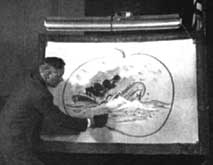
We attribute some of the earliest chalk talks to a pastor and evangelist named P.H. Kadey. He loved to sing as he drew. He also became well known for his cartoon drawings against evolution.
Percy H. Kadey was born on November 19, 1887, in Caradoc, Ontario. Rev. Kadey and his wife, Amelia, had six children and resided in Port Huron, Michigan, in the 1910-20s. P.H. Kadey once held a revival in Port Huron that included three churches. More than 450 went forward to the altar. Kadey also wrote poetry and occasional articles, which appeared in Moody Monthly magazine in the 1920s.
By the 1930s Rev. Kadey was residing in Flint, Michigan, where he was pastor of the Flint Gospel Assembly. While drawing for a group of students, he inspired Esther Frye to begin chalk art. He continued with his evangelistic chalk talks over the next few decades, often singing hymns while he drew. His poems and some illustrations appeared in various evangelical Christian magazines at that time. Much of this material was derived from his chalk talks. P.H. Kadey departed from this earthly life in September 1965.
Dr. W. Karl Steele (1910-1982)
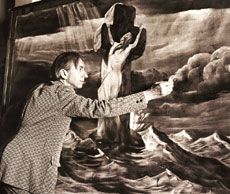 The first black-light chalk artist. Karle Steele, First Black Light Chalk ArtistDr. Karl Steele was born in Finley, Ohio, in September 1910. He was a gifted and well-known oil painter whose love for oils certainly carried over into his chalk art. He first did chalk art for his youth group in Elkhart, Indiana. He felt that God had called him to a preaching ministry. This call surprised him because his speech was stuttered and he had trouble speaking in public. However, he surrendered to he Lord's calling in his life and went to the John Herron Art Academy to further his art training.
The first black-light chalk artist. Karle Steele, First Black Light Chalk ArtistDr. Karl Steele was born in Finley, Ohio, in September 1910. He was a gifted and well-known oil painter whose love for oils certainly carried over into his chalk art. He first did chalk art for his youth group in Elkhart, Indiana. He felt that God had called him to a preaching ministry. This call surprised him because his speech was stuttered and he had trouble speaking in public. However, he surrendered to he Lord's calling in his life and went to the John Herron Art Academy to further his art training.
Dr. Steele traveled abroad with a repertoire of nearly 50 different drawings. He was also a part of the early years of ministry at the Maranatha Conference Center in Muskegon, Michigan. At one of the meetings in the early 1940s in Maranatha's tabernacle, Dr. Steele first used the invisible black-light chalk he had made. His drawing was the translation of Elijah. When Dr. Steele turned on the black light at the end of the drawing, it revealed a fire chariot he had drawn ahead of tim with his new black-light chalk. He was making history! The audience was amazed in the same way people are today when they see a hidden image appear in a chalk talk. His ministry at Maranatha continued for 35 years. Dr. Steele set up art departments at Bob Jones University and Wheaton College. His unique use of the talents God gave him touched the lives of thousands of people across America. Dr. Steele never charged for his service and used live, local music when he drew his pictures in meetings.
Christian chalk artists through the years have acknowledged his unique ability through the media of chalk and lighting to simply present complicated Biblica messages. Dr. Steele's faithful ministry continued until just a few months before the Lord called him home.
Esther Frye (1914-2011)
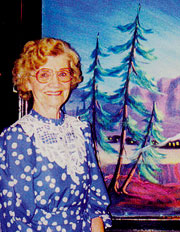 Esther Frye was born on May 8, 1914, in Stanton, Michigan. She was first introduced to chalk art while watching P.H. Kadey draw at her school in 1930. She eventually became a student of Karl Steele. Esther dedicated her life to the Lord at a young age. She performed her first chalk talk at the age of 21. She drew in all kinds of meetings in churches, Bible camps, prisons, Indian reservations, and public schools.
Esther Frye was born on May 8, 1914, in Stanton, Michigan. She was first introduced to chalk art while watching P.H. Kadey draw at her school in 1930. She eventually became a student of Karl Steele. Esther dedicated her life to the Lord at a young age. She performed her first chalk talk at the age of 21. She drew in all kinds of meetings in churches, Bible camps, prisons, Indian reservations, and public schools.
Esther married Bertis "Bert" Frye on April 2, 1944. They had one son named Jonathan. Ester loved to quote Scripture and tell stories as she drew. Her bold strokes and dramatic stories captivated audiences. Esther Frye went home to me with the Lord on July 11, 2011, at the age of 97. Her life story on DVD (Snatch from the Fire) is available from Eternity Arts.
Dr. Phil Saint (1912-1993)
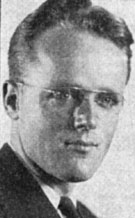 Phil Saint was born in Jenkintown, Pennsylvania, in October 1912. Phil's brother Nate was one of the famous martyred missionaries in Ecuador. From an early age, Phil loved to draw. He often watched his father, Lawrence B. Saint, at work painting in oil or making the beautiful stained glass windows for the National Cathedral in Washington, D.C. At the age of five little Philip was a believer in Jesus Christ. Early on it was discovered that Phil was 50% color blind. He recognized the importance of using colors, so with the help of other people, he memorized where the different colors wherein his chalk tray to avoid using the wrong color.
Phil Saint was born in Jenkintown, Pennsylvania, in October 1912. Phil's brother Nate was one of the famous martyred missionaries in Ecuador. From an early age, Phil loved to draw. He often watched his father, Lawrence B. Saint, at work painting in oil or making the beautiful stained glass windows for the National Cathedral in Washington, D.C. At the age of five little Philip was a believer in Jesus Christ. Early on it was discovered that Phil was 50% color blind. He recognized the importance of using colors, so with the help of other people, he memorized where the different colors wherein his chalk tray to avoid using the wrong color.
Phil worked for a time as secretary/chauffeur for Herbert Johnson, the famous national cartoonist where cartoons regularly appeared in newspapers of that time. After several years as a traveling evangelist, Phil married Ruth Brooker, who was also called to Christian service. They were married in October 1941 and enjoyed 51 years together.
Phil traveled a lot all his life, doing chalk talks throughout the United States and in Japan, the Caribbean, Uruguay, and Argentina. During his visit to Cordoba, Argentina, God called him to move there as a missionary, Phil participated in many evangelistic campaigns inside and outside Argentina. When he discovered that in many places an adequate auditorium was not available, Phil bought a tent that could hold 2,000 people. As a result of his ministry, thousands of people responded to the Gospel as he drew, sang, and preached. He died in Argentina at the age of 80 in a tractor accident with chalk under his fingernails and oil paint on his hands.
Ding Teuling (1918-2016)
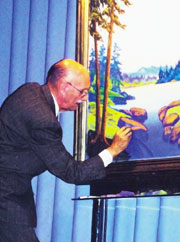 Born April 23, 1918, in Muskegon, Michigan, Mr. Ding Teuling is recognized throughout the world as the Dean of Chalk Artistry. His innovative techniques have set him apart as one of the pioneers of black-light drawing. Ding was inspired to begin chalk art at an early age by watching the work of Esther Frye. He would later inspire Bill Gothard by drawing at young Bill's church. Ding's background in commercial art contributed to his expertise. For many years he taught classes in chalk artistry and traveled abroad. He has equipped numerous missionaries, pastors, seminar speakers, young people, and others to minister through chalk art. He and his wife, Gloria, had three children and lived in Muskegon, Michigan. Ding went home to be with the Lord on September 3, 2016, at the age of 98.
Born April 23, 1918, in Muskegon, Michigan, Mr. Ding Teuling is recognized throughout the world as the Dean of Chalk Artistry. His innovative techniques have set him apart as one of the pioneers of black-light drawing. Ding was inspired to begin chalk art at an early age by watching the work of Esther Frye. He would later inspire Bill Gothard by drawing at young Bill's church. Ding's background in commercial art contributed to his expertise. For many years he taught classes in chalk artistry and traveled abroad. He has equipped numerous missionaries, pastors, seminar speakers, young people, and others to minister through chalk art. He and his wife, Gloria, had three children and lived in Muskegon, Michigan. Ding went home to be with the Lord on September 3, 2016, at the age of 98.


